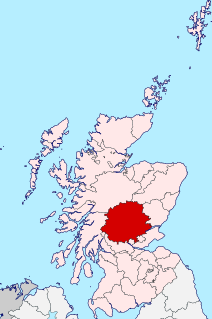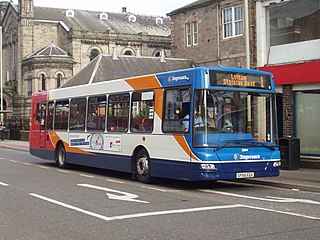
Perthshire, officially the County of Perth, is a historic county and registration county in central Scotland. Geographically it extends from Strathmore in the east, to the Pass of Drumochter in the north, Rannoch Moor and Ben Lui in the west, and Aberfoyle in the south; its borders the counties of Inverness-shire and Aberdeenshire to the north, Angus to the east, Fife, Kinross-shire, Clackmannanshire, Stirlingshire and Dunbartonshire to the south and Argyllshire to the west. It was a local government county from 1890 to 1930.
Local government in Scotland is organised through 32 unitary authorities designated as councils which consist of councillors elected every five years by registered voters in each of the council areas.

The Local Government etc. (Scotland) Act 1994 is an Act of the Parliament of the United Kingdom which created the current local government structure of 32 unitary authorities covering the whole of Scotland.

The North British Railway was a British railway company, based in Edinburgh, Scotland. It was established in 1844, with the intention of linking with English railways at Berwick. The line opened in 1846, and from the outset the Company followed a policy of expanding its geographical area, and competing with the Caledonian Railway in particular. In doing so it committed huge sums of money, and in doing so incurred shareholder disapproval that resulted in two chairmen leaving the company.
The Royal Incorporation of Architects in Scotland (RIAS) is the professional body for architects in Scotland.

Stagecoach East Scotland is an operating region of Stagecoach UK Bus, with its regional base in Dunfermline, Fife, Scotland. Its legal operations come under "Fife Scottish Buses Ltd" the company operators under six different brands:
A provost is the ceremonial head of Scottish local authorities, and under the name prévôt was a governmental position of varying importance in Ancien Régime France.

Perth railway station is a railway station located in the city of Perth, Scotland. The station, designed by Sir William Tite, won an architecture prize. It has seven platforms, five of which are "through" platforms.

Angus was a constituency of the Scottish Parliament (Holyrood). It elected one Member of the Scottish Parliament (MSP) by the first past the post method of election. Also, however, it was one of nine constituencies in the North East Scotland electoral region, which elects seven additional members, in addition to nine constituency MSPs, to produce a form of proportional representation for the region as a whole.
Scottish Westminster constituencies were Scottish constituencies of the House of Commons of the Parliament of Great Britain, normally at the Palace of Westminster, from 1708 to 1801, and have been constituencies of the House of Commons of the Parliament of the United Kingdom, also at Westminster, since 1801. Constituency boundaries have changed on various occasions, and are now subject to both periodical and ad hoc reviews of the Boundary Commission for Scotland.
Community Health Partnerships, known as CHPs were subdivisions of Health Boards in Scotland, from 2005 to 2015, after which their functions were fully taken over by Health and Social Care Partnerships in April 2015.

The 2011 Scottish Parliament election was held on Thursday, 5 May 2011 to elect 129 members to the Scottish Parliament.
The Scottish North Eastern Railway was a railway company in Scotland operating a main line from Perth to Aberdeen, with branches to Kirriemuir, Brechin and Montrose. It was created when the Aberdeen Railway amalgamated with the Scottish Midland Junction Railway on 29 July 1856. It did not remain independent for long, for it was itself absorbed by the Caledonian Railway on 10 August 1866.
Scouting in Scotland is largely represented by Scouts Scotland, a registered Scottish Charity No. SC017511 that is affiliated to the Scout Association of the United Kingdom. The Baden-Powell Scouts' Association also has a presence in Scotland.
A Strategic Development Planning Authority is a partnership established under the Planning etc (Scotland) Act 2006 to prepare and keep under review a strategic development plan for its area. There are currently four Strategic Development Planning Authorities (SDPAs) in Scotland, covering the four largest city regions - Aberdeen, Dundee, Edinburgh and Glasgow.
A sheriffdom is a judicial district of Scotland. Originally identical to the Shires of Scotland, from the eighteenth century many counties were grouped to form "sheriffdoms".
Health and Social Care Partnerships, (HSCPs) are the organisations formed as part of the integration of services provided by Health Boards and Councils in Scotland. Each partnership is jointly run by the NHS and local authority.
The Railways of Kinross were a local network of three rural railways which made the town of Kinross in Scotland their objective in the 1859s.











